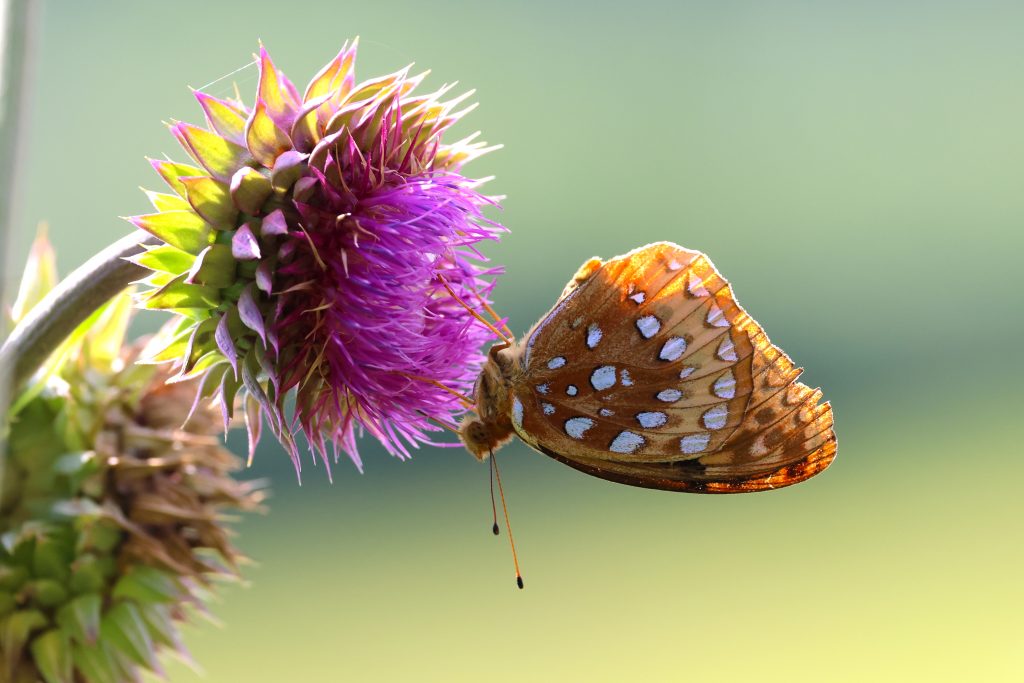Butterfly Effect: How Pollinators Impact Wild Turkeys and the World
The butterfly effect rests on the notion that the world is deeply interconnected, such that one small occurrence can influence a much larger complex system.
Bees buzz. Butterflies flutter. Other bugs and birds do their thing as well. Simultaneously, a gobbler sounds off in the distance. It’s a beautiful spring scene, and one that’s more fragile than most realize. The delicate balance of life hinges on the existence of the smallest of beings visible to the naked eye. Bugs help with plant pollination. Without pollination, life as we know it ceases to exist.

Ants, bats, bees, beetles, birds, butterflies, flies, moths, wasps and other more obscure insects or small animals are considered the most important pollinators. Of these, bees and butterflies do much of the work.
Per the National Wildlife Federation, more than 100,000 invertebrates (bees, butterflies, beetles, flies, moths, wasps, etc.) and more than 1,000 amphibians, birds, reptiles and mammals are responsible for pollination. When these animals and insects feed on pollen and nectar, they transfer pollen from one plant to the next.
What Do Pollinators Achieve?
When pollinators carry pollen from plant to plant, they effectively assist the reproduction process of flowering plant species. More specifically, they transfer the pollen from a male plant’s anther to the female plant’s stigma. Without these pollinators, most plants can’t produce seeds, including fruit or nuts.
“Pollinators are the lifeblood of the ecosystem,” said Derek Alkire, NWTF district biologist in Alabama, Kentucky, and Tennessee.
According to the U.S. Department of Agriculture, approximately 80% of all flowering plants and more than 75% of vital crop plants rely on pollinators. Pollinators are responsible for one out of every three foods that humans eat, reports the USDA. Much the same is true for wild turkeys and other upland game species. Everything that eats relies on pollinators in some fashion.

Besides the seeds and other foods provided by pollinated plants, many pollinating insects also serve as important turkey food.
“Turkey poults require a diet rich in insects during the first few weeks of life,” Alkire said. “Along with grasshoppers and other insects, pollinators such as beetles provide a good protein source for turkey poults.”
Pollinators impact turkeys from an indirect perspective, too.
“Pollinator habitat provides great wild turkey habitat,” he said. “Pollinator habitat is comprised of a diversity of plant species that provide great structure for wild turkeys, especially broods.”
Kacie Bauman, NWTF district biologist in Arkansas, Louisiana, and Mississippi, notes that pollinators also help spread seeds. This can help establish additional food sources as those seeds begin to grow.
Pollinator Numbers in Decline
Pollinators are symbiotic with most mammals, including wild turkeys. Where bees, butterflies and other insects thrive, so do wild turkeys. But pollinator species are in decline, something that concerns biologists and other people interested in healthy habitats.
“Pollinators are often a sign of relatively good turkey habitat due to the types of plant species to which pollinators are attracted,” Bauman said. “These plant species provide not only food but also cover from predators as well, allowing for free movement on the ground.”
Numerous threats are impacting these pollinating animals and insects. Habitat loss, pesticide use and disease take a high toll. Monarch butterflies, for example, have declined by 90% in just the past two decades.
Landowners Can Help
Landowners can help promote pollinator numbers with the resultant effect of improving agriculture and flowering plants.
“Landowners should welcome pollinators. Quality pollinator habitat is quality turkey habitat,” Alkire said. “By promoting pollinators on a property, the landowner is creating quality nesting and brooding habitat, which is a limiting component across the landscape. The NWTF Habitat for the Hatch Initiative is working to create wild turkey nesting and brooding habitat that also increases pollinator abundance and, thus, provides more resources for the wild turkey.”
Land managers can promote pollinators and their habitat by discing, burning and conducting timber stand improvement activities, Alkire said.
“Implementing prescribed fire at the appropriate time and scale can create excellent pollinator habitat,” he added. “This pollinator habitat is also beautiful as it typically has abundant wildflowers that are aesthetically pleasing during bloom. Fallow discing around field edges or on fire lines can manipulate the plant structure to promote more pollinator friendly growth.”
Bauman recommends adding pollinator plant species to wildlife openings. Sometimes, too, a simple disturbance of the ground at various times of the year will promote the native seed bank to come alive and grow.
“It is important to remember that most pollinator plant species are susceptible to being overgrown by invasive plant species,” Bauman said, “so a proper herbicide or burn rotation plan is advisable when trying to establish pollinator species.”
If nothing else, land managers should consider reducing pesticide use. According to Xerces (www.xerces.org/pesticides), pesticides rarely distinguish between harmful invertebrates that destroy crops and the insects that serve crops as pollinators. This harms natural ecosystems, reducing pollinator numbers and, possibly, contributing to turkey population decline.
For more information on pollinator conservation in your region (https://www.xerces.org/pollinator-resource-center), visit xerces.org.
Alkire explains that decreasing pollinator populations, especially bees and butterflies, is generating considerable federal interest, with funding available to help landowners manage and improve the situation for these species.
“Using these federal and state programs to manage for some of these pollinator species also helps landowners do great work for the wild turkey,” he said.
Bees (and Other Buzzers) on the Brink

A significant bee population decline is underway. The same is true for other invertebrates that serve as pollinators. The numbers are shocking.
- 19% of U.S. butterflies are at risk.
- 27% of mason bee species are at risk.
- 28% of bumble bee species are in decline.
- 50% of leafcutter bees are at risk.
Note: Data courtesy of Xerces.org (https://www.xerces.org/pollinatorconservation/whats-at-stake)
